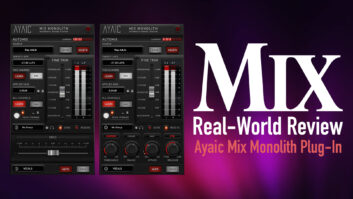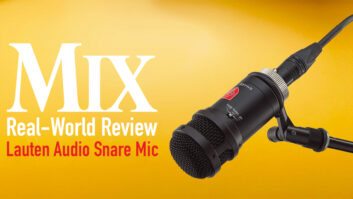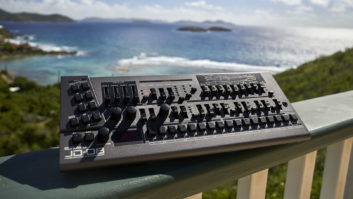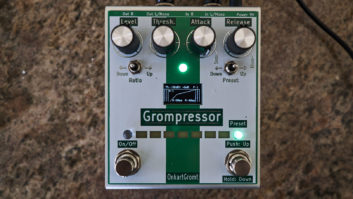
| MIX VERDICT: EQUI=TECH 2RQ BALANCED POWER SYSTEM |
| THE TAKEAWAY: “When recording direct guitars, direct keyboards or vocals, I found the noise floor is, in some cases, low enough that I can start to hear my gear’s noise that previously was covered by the studio’s AC line noise and hum.” |
| COMPANY: Equi=Tech • www.equitech.com PRICE: 2R is $3,999, 2RQ is $6,999 MSRP PROS: • Noise floor is lowered significantly. CONS: • Pricey. |
New York, NY (November 25, 2025)—It’s not surprising that musicians, producers and even recording engineers don’t think much about the AC power coming out of their wall sockets. It’s a utility, “plug and play,” but utility companies have to distribute electricity to share it among homes and businesses over a wide service area, with miles of power lines that are subject to and “polluted” by a wide variety of noise, radio frequency interference, digital noise from adjacent signal cables on the same pole and the huge variation in customer power demands. Utility companies provide power up to your business or residence with no guarantees of its purity. Equi=Tech founder, the late Martin Glasband, realized the problems with AC power early on when attempting to de-noise a recording studio.
First, a quick refresher. Residential AC power in the U.S. comes to our homes and businesses from the electric utilities’ line transformer as 240 volts. The transformer’s 240V secondary is center-tapped, splitting the voltage into two opposite-phased 120V legs, sometimes called L1 and L2. Both legs share the center-tapped point, called the neutral. This allows the entire 240V feed to be used for energy-hungry appliances such as electric stoves, heaters and air-conditioners, while the rest of the draw—including your studio—connects to either of the 120V L1 or L2 legs.
A balanced, or symmetrical, power system uses an isolation transformer to convert the single-phase, unbalanced 120V AC into two, oppositely phased 60-volt legs. Instead of (unbalanced) 120V hot (black wire) and neutral (white) pins on the rear-panel socket of your equipment, there are now 60 volts on each pin.
The third pin on AC plugs and sockets is called a chassis, or “technical ground.” This is for grounding the gear’s metal chassis and should always be used and maintained for shielding and safety—never defeat or disconnect it. All of your gear works the same using balanced power, and when implemented correctly, electrical interference, ground noise, hum, hiss, and radio frequency interference “riding” in on the incoming unbalanced AC line are reduced.
Designed for small, project/home studios, the Equi=Tech 2RQ is a 2U rackmounted unit that does not require a wall-panel installation, modifications or an electrician to set up. It has a capacity of 2 kVA (2,000 watts), and peak output current is 20 amps with a continuous rating of 16.3 amps. It plugs into a 20-amp NEMA 5-20 c20 wall receptacle via an included cable. Weighing 72 pounds and measuring 3.5 x 16 x 16 inches (HWD), the 2RQ is designed to be installed at the bottom of an equipment rack.
A built-in digital AC volt meter can read either the input or output voltage, but not current. By design, the output voltage is 3 volts higher than the input voltage. Because it uses the company’s patented LoNo technology with a massive, hermetically sealed toroid transformer, the 2RQ made no audible noise/buzzing while it sat on the floor next to me for this review.
It radiates very little AC hum that could spoil direct guitar recordings in the control room. To suppress electromagnetic field radiation, Equi=Tech’s toroid uses bifilar windings and a multi-layer Faraday shielding—a design invented in 1992 by Glasband. Though more expensive, toroid transformers are 50% lighter and radiate less field noise than equivalently rated, conventional, EI-framed models.
It was easy to distribute AC power to each of my outboard racks using the appropriate socket(s) on the back panel of the 2RQ. My studio has a dedicated, single 20-amp wall receptacle with its own circuit breaker and separate, isolated ground cable going back to the breaker panel, and a ground rod driven into the earth. (If you don’t have this, the unit will still function perfectly.) The rear panel of the 2RQ includes multiple power connections.
The 2RQ provides balanced power to 12 AC receptacles. There are two always-on GFCI (Ground Fault Circuit Interrupter) sockets that will shut down power to all sockets in the event of a problem, such as the ground pin inadvertently connected to the neutral! The GFCI serves as a caution, a fail-safe to find and fix the problem immediately.
Analogue Tube AT-3 Mic Preamp — A Mix Real-World Review
Next are four digital filtered (gray-colored) outlets that have 22kHz low-pass filters. These sockets suppress line noise and electromagnetic interference emanating from nearby computers, DACs, cell phones, small switch-mode power supplies (wall-warts) and digital signal processors. Rounding it out, there are six conventional AC sockets for all other analog outboard gear, such as power amps, tape recorders, consoles, compressors, etc. It would be nice to see an additional 20-amp NEMA 5-20, c20 receptacle here.
The manual has a list of “do’s and don’ts,” rules to follow such as “do not ever defeat or lift the ground connection on any AC plug.” There are also some block diagrams and examples of proper connections, as well as links to unique setups and information about equipment grounding.
In my studio, all my gear is grounded with separate ground cables to a common bus bar that is connected to a ground rod outside. I use the other socket on the wall receptacle for powering a Furman M1500 UPS that keeps alive my Pro Tools computer, LG monitors, SSDs and a small Bryston amp for desktop speaker cubes during power outages. I plug everything else into the 2RQ in Standby mode with the toroid energized.
When I switch out of Standby, it is a smooth power-up to three Avid interfaces, an Eventide H9000, Cranesong Avocet II monitor controller, Interstellar ADC and a Trinnov Nova system. The eight white sockets get analog outboard, including: four 500 Series racks, a big rack of tube gear, a large Bryston power amp, a Hafler amp for headphones and my Focal powered monitors. I turn on this gear as needed.
Discover more great reviews—get a free Mix SmartBrief subscription!
Since using the 2RQ, I’ve noticed a major improvement in how my studio sounds and operates. It is more stable, with less weird Pro Tools behavior and glitches—only the computer is on the UPS. The easiest listening test is with a mastering session open but not playing; I can crank up my Avocet’s main volume to the max with the Trinnov Nova adding +20 dB to that, and I only hear a quiet hiss and almost no hum. Before using the 2RQ, this was not the case at all.
I had a tech come over and measure the noise floor of the AC line coming into the studio and then out of the 2RQ. Noise was about -130 dBu in/out while under load (i.e., no difference).
When recording direct guitars, direct keyboards or vocals I found the noise floor is, in some cases, low enough that I can start to hear my gear’s noise that previously was covered by the studio’s AC line noise and hum. The Equi=Tech 2RQ has been an amazing upgrade for my studio, and I want it!







